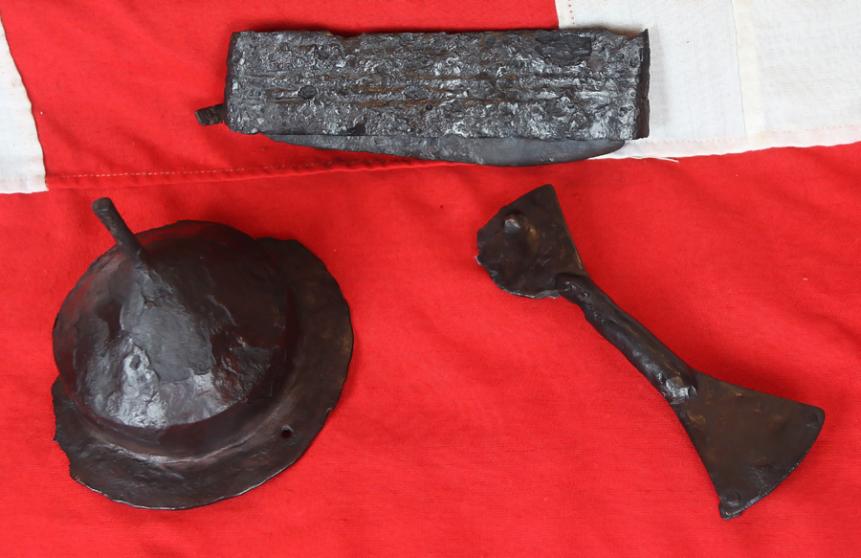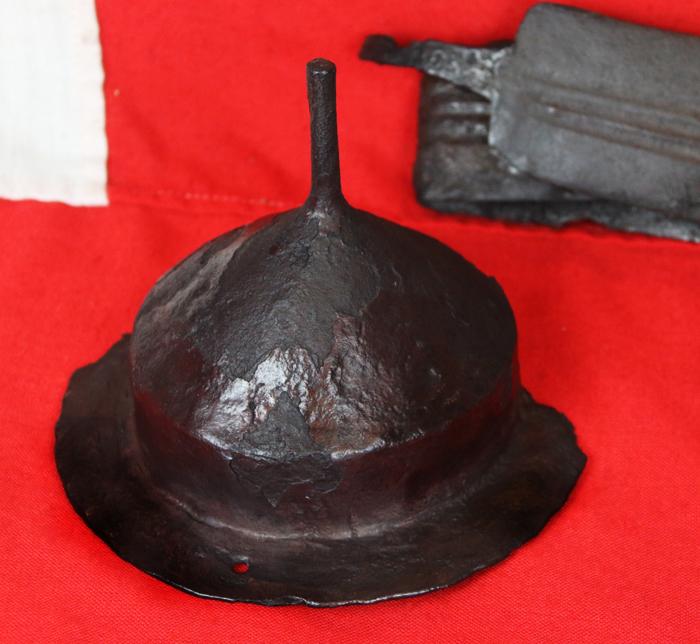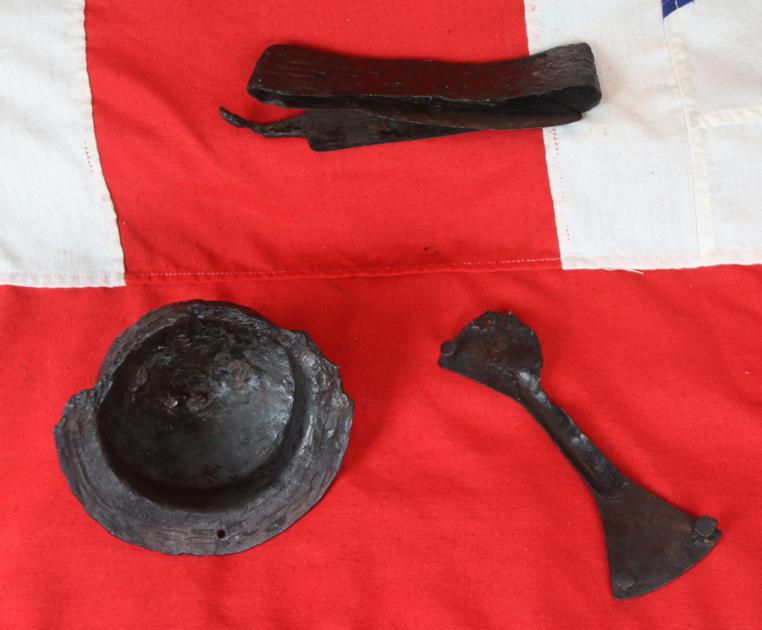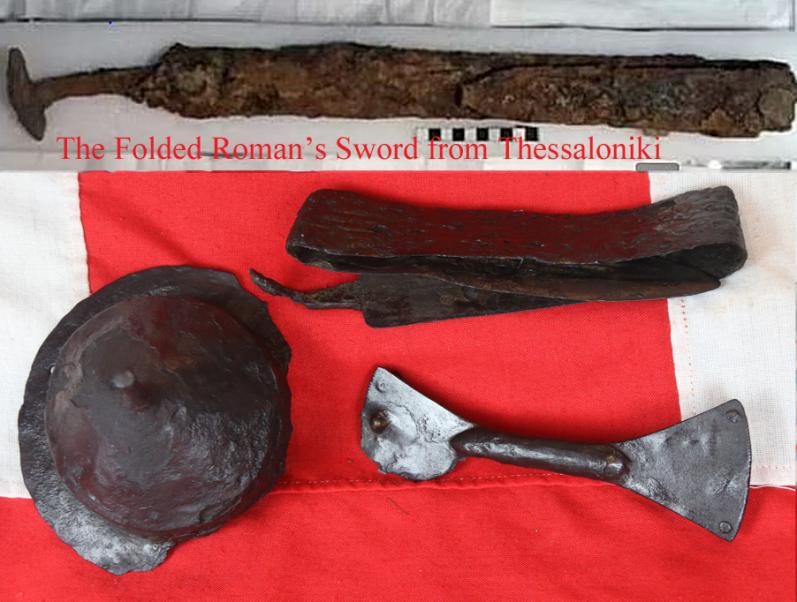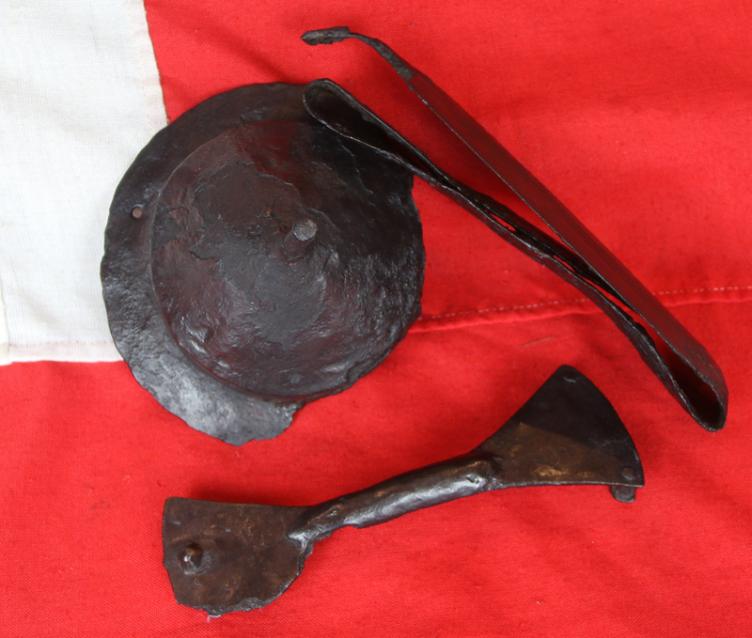A Superb & Very Rare Original Grouping, 5th to 7th Century Roman & Goth Period 'Ceremonially Folded' Sword, From a Pagan Ritual, A Warrior or Legionary's Spartha Sword, and War Shield Mounts
A very similar find of a Roman sword and shield boss was excavated in Greece last May, and caused a sensation and world news. The 'astonishing' findings have been shared by Errikos Maniotis, an archaeologist at Aristotle University of Thessaloniki in Greece, who believes the man likely served in the Roman imperial army.
'Usually, these types of swords were used by the auxiliary cavalry forces of the Roman army,' Maniotis told Live Science.
'Thus, we may say that the deceased, taking also into consideration the importance of the burial location, was a high-ranking officer of the Roman army.
It's rare to find a 'folded' sword in an urban landscape, let alone in this part of Europe, Maniotis pointed out. The term 'folded' sword describes that it has been believed to have been ceremonially killed and bent, in a pagan rite, to sacrifice the sword from current use, to represent a warrior passing into the afterlife, for it to be used in the afterlife by the warrior, and thus buried with his shield and offerings to the gods. Our sword group is around 1400 to 1600 years old. It was likely recovered more up to two centuries ago, probably a ‘Grand Tour’ find, from the area historically known as Merovingian Roman-Frankish Germany or France. The shield boss and handle have survived remarkably well, naturally the leather covered wooden shield body and sword hilt have rotted away over its 1200 plus years underground. The organic parts of shields and swords simply never survive this great period of time being buried. For example, we know not of a single complete Viking wooden shield in existence today, the only way we know today of their appearance is from ancient texts and poems that have survived. The spatha is a type of straight and long sword, measuring between 0.75 and 1 m , with a handle length between 18 and 20 cm , in use in the territory of the Roman Empire during the 1st to 6th centuries AD. Later swords, from the 6th to 10th centuries, like the Viking swords, are recognisable derivatives and sometimes subsumed under the term spatha.
The Roman spatha was used in war and in gladiatorial fights. The spatha of literature appears in the Roman Empire in the 1st century AD as a weapon used by presumably Germanic auxiliaries and gradually became a standard heavy infantry weapon, relegating the gladius to use as a light infantry weapon. The spatha apparently replaced the gladius in the front ranks, giving the infantry more reach when thrusting. While the infantry version had a long point, versions carried by the cavalry had a rounded tip that prevented accidental stabbing of the cavalryman's own foot or horse.
Archaeologically many instances of the spatha have been found in Britain and Germany. It was used extensively by Germanic warriors. It is unclear whether it came from the Pompeii gladius or the longer Celtic swords, or whether it served as a model for the various arming swords and Viking swords of Europe. The spatha remained popular throughout the Migration Period. It evolved into the knightly sword of the High Middle Ages by the 12th century. Picture of combating Frankish warrior knights using spartha and shields of the same type, from the Stuttgart Psalter.
The Merovingians were a Salian Frankish dynasty that ruled the Franks for nearly 300 years in a region known as Francia in Latin, beginning in the middle of the 5th century. Their territory largely corresponded to ancient Gaul as well as the Roman provinces of Raetia, Germania Superior and the southern part of Germania. The semi legendary Merovech was supposed to have founded the Merovingian dynasty, but it was his famous grandson Clovis I (ruled c.481-511) who united all of Gaul under Merovingian rule. Charles de Gaulle is on record as stating his opinion that "For me, the history of France begins with Clovis, elected as king of France by the tribe of the Franks, who gave their name to France. Before Clovis, we have Gallo-Roman and Gaulish prehistory. The decisive element, for me, is that Clovis was the first king to have been baptized a Christian. My country is a Christian country and I reckon the history of France beginning with the accession of a Christian king who bore the name of the Franks. The Merovingians are featured in the book The Holy Blood and the Holy Grail (1982) where they are depicted as descendants of Jesus, inspired by the "Priory of Sion" story developed by Pierre Plantard in the 1960s. Plantard playfully sold the story as non-fiction, giving rise to a number of works of pseudohistory among which The Holy Blood and the Holy Grail was the most successful. The "Priory of Sion" material has given rise to later works in popular fiction, notably The Da Vinci Code (2003), which mentions the Merovingians in chapter 60 . The ritual 'killing' of swords, such as bending or breaking have been found in thousands of examples of this practice across Europe, indicating that it was a ritual common to all the pan-Celtic tribes. However, although many theories have been postulated, for now the exact significance of this mysterious custom remains unclear. Some suggest it may be for all to know that the blade is not to recovered by grave robbers, or, possibly, the warrior or knight owner has been killed in battle, and thus his sword, as part of him, is also now dead. Or, maybe an offering to the gods of the afterlife. A Merovingian Frankish sword in 'un-killed' condition, is such a rare piece to survive to today, would likely be valued comfortably into five figures £12,000 plus. In May 2021 An iron sword deliberately bent as part of a pagan ritual has been discovered in a Roman soldier's grave in Greece, an archaeologist has revealed.
The deformed or 'folded' sword was buried with an as yet unidentified soldier about 1,600 years ago in the Greek city of Thessaloniki.
His 'arch-shaped' grave was found in the underground remains of a basilica – a large public building and place of worship – dating from the fifth century AD. 'Folded swords are usually excavated in sites in Northern Europe,' he said.
'It seems that Romans didn't practise it, let alone when the new religion, Christianity, dominated, due to the fact that this ritual was considered to be pagan.'
Archaeologists are yet to assess the remains of the soldier, described as likely a 'Romanized Goth or from any other Germanic tribe who served as a mercenary'.
'We don't know anything about his profile – age of death, cause of death, possible wounds that he might have from the wars he fought,' Maniotis said.
The soldier's grave was one of seven found in the basilica, but not all of them were found containing artefacts. in the third century A.D., the Goths launched a series of raids into the Roman Empire. “The first known attack came in 238, when Goths sacked the city of Histria at the mouth of the river Danube. A series of much more substantial land incursions followed a decade later,” writes Peter Heather, a professor at King’s College London, in his book “The Goths” (Blackwell Publishers, 1996).
He notes that in A.D. 268, a massive expedition of Goths, along with other groups also called barbarians, broke into the Aegean Sea, wreaking havoc. They attacked a number of settlements, including Ephesus (a city in Anatolia inhabited by Greeks), where they destroyed a temple dedicated to the goddess Diana.
“The destruction wrought by this combined assault on land and sea were severe, and prompted a fierce Roman response. Not only were the individual groups defeated, but no major raid ever again broke through the Dardanelles,” writes Heather.
The Goths' tumultuous relationship with Rome would continue into the fourth century. While Goths served as Roman soldiers, and trade took place across the Danube River, there was plenty of conflict.
Heather notes that a Gothic group called the Tervingi intervened in Roman imperial politics, supporting two unsuccessful claimants to the emperorship. In A.D. 321, they supported Licinius against Constantine, and in A.D. 365, they supported Procopius against Valens. In both instances this backfired, with Constantine and Valens launching attacks against the Tervingi after becoming emperor.
As contact with Rome intensified, a form of Christianity known as Arianism spread among the Goths.
“In the 340s, the Arian Gothic bishop Ulfilas or Wulfila (d. 383) translated the Bible into the Gothic language in a script based chiefly upon the uncial Greek alphabet and said to have been invented by Ulfilas for the purpose,” writes Robin Sowerby, a lecturer at the University of Stirling, in an article in the book “A New Companion to the Gothic” (Wiley, 2012).
In time, the Goths would adopt the Catholic form of Christianity that came to be used in Rome. ; From a private collection of an English gentleman acquired in the 1940's. As with all our items it comes complete with our certificate of authenticity. Almost every iron weapon that has survived today from this era is now in a fully russetted condition, as is this one, because only the swords of kings, that have been preserved in national or Royal collections are today still in a relative good state and condition. We show in the gallery two photos of the excavated Roman's tomb in Thessaloniki, and the Roman's folded spartha sword. In the photo of the tomb interior one can plainly see the folded sword and shield boss, the shield boss has been crushed flat. Another photograph is of the exhibit in the museum of Nuremberg Germany showing another original spartha sword unfolded and a fully formed shield boss, both are extremely similar to ours.
A sword was still so valued in the much later Norse society that good blades were prized by successive generations of warriors. There is even some evidence from Viking burials for the deliberate and possibly ritual "killing" of swords, a ritual from ancient times, which still involved the blade being bent so that it was unusable. Because Vikings were often buried with their weapons, the "killing" of swords may have served two functions, namely a ritualistic function in retiring a weapon with a warrior, and a practical one in deterring any grave robbers from disturbing the burial in order to get one of these costly weapons. Indeed, archaeological finds of the bent and brittle pieces of metal sword remains testify to the regular burial of Vikings with weapons, as well as the habitual "killing" of sword
Code: 21852
4950.00 GBP


